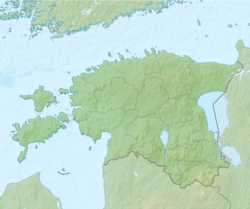This article needs additional citations for verification. (November 2016) |
This article may require copy editing for grammar, style, cohesion, tone, or spelling. (January 2024) |
Paldiski | |
|---|---|
 | |
| Coordinates: 59°21′N 24°03′E / 59.350°N 24.050°E | |
| Country | |
| County | |
| Municipality | |
| First historical record | 1377 |
| Fortress established | 20 July 1718[1] |
| Town rights | 3 July 1783[2] |
| Area | |
| • Total | 60.2 km2 (23.2 sq mi) |
| Highest elevation | 31 m (102 ft) |
| Lowest elevation | 0 m (0 ft) |
| Population (2021)[3] | |
| • Total | 3,542 |
| • Rank | 27th |
| • Density | 59/km2 (150/sq mi) |
| Ethnicity (2021) | |
| • estonians | 34.8% |
| • russians | 51.8% |
| • ukrainians | 6.35% |
| • other | 7.05% |
| Time zone | UTC+2 (EET) |
| • Summer (DST) | UTC+3 (EEST) |
| Postal Codes | 76801, 76804-76807, 76891[5] |
Paldiski is a town and Baltic Sea port located on the Pakri Peninsula in northwestern Estonia. Originally established as a small Swedish port known as Rågervik, it evolved into an important ice-free port upon being incorporated into the Russian Empire in the 18th century.
Following Estonia's independence in 1918, the port experienced a decline in significance, only to regain importance during the Soviet occupation. However, upon Estonia's restoration of independence, it subsequently diminished in significance once again.
The town is home to the terminus of the Tallinn-Paldiski railway line and serves as the administrative center of Lääne-Harju Parish in Harju County.
As of 1 January 2021, the town had a population of 3542.
- ^ Cite error: The named reference
paldiskilinnajaluguwas invoked but never defined (see the help page). - ^ Cite error: The named reference
paldiskitownrightswas invoked but never defined (see the help page). - ^ "Population by sex, age group and place of residence after the 2017 administrative reform, 1 January". Statistics Estonia. Retrieved 27 December 2021.
- ^ Cite error: The named reference
RL21429was invoked but never defined (see the help page). - ^ "Eesti postiindeksid ning sihtnumbrid". postiindeks.ee.


